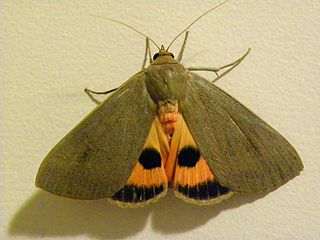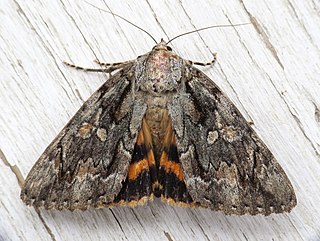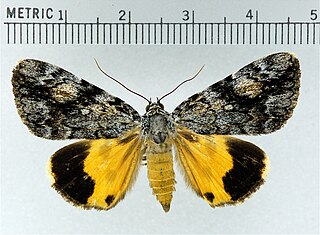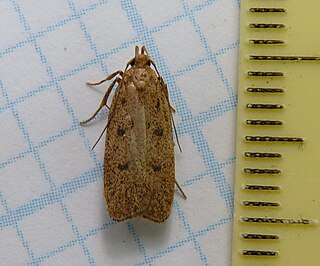
The Noctuidae, commonly known as owlet moths, cutworms or armyworms, are a family of moths. They are considered the most controversial family in the superfamily Noctuoidea because many of the clades are constantly changing, along with the other families of the Noctuoidea. It was considered the largest family in Lepidoptera for a long time, but after regrouping Lymantriinae, Catocalinae and Calpinae within the family Erebidae, the latter holds this title now. Currently, Noctuidae is the second largest family in Noctuoidea, with about 1,089 genera and 11,772 species. This classification is still contingent, as more changes continue to appear between Noctuidae and Erebidae.

The Nymphalinae are a subfamily of brush-footed butterflies. Sometimes, the subfamilies Limenitidinae, and Biblidinae are included here as subordinate tribe(s), while the tribe Melitaeini is occasionally regarded as a distinct subfamily.

The Ophiusini are a tribe of moths in the family Erebidae.

The Calpinae are a subfamily of moths in the family Erebidae described by Jean Baptiste Boisduval in 1840. This subfamily includes many species of moths that have a pointed and barbed proboscis adapted to piercing the skins of fruit to feed on juice, and in the case of the several Calyptra species of vampire moths, to piercing the skins of mammals to feed on blood. The subfamily contains some large moths with wingspans longer than 5 cm (2 in).

The Pyralini are a tribe of snout moths described by Pierre André Latreille in 1809. They belong to the subfamily Pyralinae, which contains the "typical" snout moths of the Old World and some other regions. The genus list presented here is provisional.

The Bistonini are a tribe of geometer moths in subfamily Ennominae. As numerous ennomine genera have not yet been assigned to a tribe, the genus list is preliminary. In addition, the entire tribe is sometimes merged into a much-expanded Boarmiini. In other treatments, the Erannini are included in the present group.

Catocala cara, the darling underwing, is an moth of the family Erebidae. The species was first described by Achille Guenée in 1852. It can be found in the United States east of the Rocky Mountains; it occurs west at least to Oklahoma and north at least to Illinois. It also ranges into southern Canada, but only barely so.

Catocala piatrix, the penitent underwing, is a moth from North America. The species was first described by Augustus Radcliffe Grote in 1864. It is placed in subfamily Catocalinae, either of the family Noctuidae, or – if the Noctuidae are circumscribed more strictly – of family Erebidae. Within the Catocalinae, it belongs to tribe Catocalini and – if the Noctuidae are circumscribed widely – subtribe Catocalina.

Catocala neogama, the bride, is a moth in the family Erebidae first described by James Edward Smith in 1797. It is found in North America east of the Rocky Mountains, from Maine and Quebec south to northern Florida and west to South Dakota, New Mexico, and into Arizona and Texas. Its westernmost population from the semiarid Colorado Plateau region is rather distinct and was once considered a separate species, but is now regarded as a well-marked subspecies C. n. euphemia.

Catocala amica, the girlfriend underwing, is a moth of the family Erebidae. The species was first described by Jacob Hübner in 1818. It is found from southern Canada through the United States east of the Rocky Mountains, ranging westward to Oklahoma and Arizona, northward to Minnesota and southwestward to Texas.

Catocala junctura, the joined underwing or Stretch's underwing, is a moth in the family Erebidae. The species was first described by Francis Walker in 1858. It is found throughout temperate North America, ranging from New York and Pennsylvania west to Montana, Colorado, Oklahoma, Arizona, and into Texas, and north to southern Illinois, extreme southern Alberta and Saskatchewan; it has also been recorded west of the Rocky Mountains from California and south-eastern British Columbia. It is typically found near water, where the food plants of its caterpillar larvae grow plentifully.

Catocala delilah, the Delilah underwing, is a moth in the family Erebidae. The species was first described by Strecker in 1874. It is found in the southern and midwestern United States, from Ohio south to Florida and west to Texas and Oklahoma.

The Depressariinae – sometimes spelled "Depressiinae" in error – are a subfamily of moths in the superfamily Gelechioidea. Like their relatives therein, their exact relationships are not yet very well resolved. It has been considered part of family Elachistidae sensu lato or included in an expanded Oecophoridae. In modern classifications they are treated as the distinct gelechioid family Depressariidae.

Esperia is a genus of the concealer moth family (Oecophoridae). Among these, it belongs to subfamily Oecophorinae. Most authors include Dasycera here, though approaches that generally follow a "splitting" approach sometimes do not.

The Symmocinae are a subfamily of moths in the superfamily Gelechioidea. These small moths are found mainly in the Palearctic and Africa.

Scythris is a genus of gelechioid moths. It is the type genus of the flower moth family, which is sometimes included as a subfamily in the Xyloryctidae, or together with these merged into the Oecophoridae. The genus was erected by Jacob Hübner in 1825.

Tinea is a genus of the fungus moth family, Tineidae. Therein, it belongs to the subfamily Tineinae. As evident by its name, it is the type genus of its subfamily and family. Established as one of the first subgroups of "Phalaena", it used to contain many species of Tineidae that are nowadays placed in other genera, as well as a few moths nowadays placed elsewhere.

The Erebinae are a subfamily of moths in the family Erebidae erected by William Elford Leach in 1815. Erebine moths are found on all continents except Antarctica, but reach their greatest diversity in the tropics. While the exact number of species belonging to the Erebinae is not known, the subfamily is estimated to include around 10,000 species. Some well-known Erebinae include underwing moths (Catocala) and witch moths (Thermesiini). Many of the species in the subfamily have medium to large wingspans, up to nearly 30 cm in the white witch moth, which has the widest wingspan of all Lepidoptera. Erebine caterpillars feed on a broad range of plants; many species feed on grasses and legumes, and a few are pests of castor bean, sugarcane, rice, as well as pistachios and blackberries.

Cryptoblabes is a genus of small moths belonging to the snout moth family (Pyralidae). They are the type genus of the Cryptoblabini tribe of the huge snout moth subfamily Phycitinae. At least one representative of this genus nowadays occurs in many parts of the world, though this is the result of accidental introductions by humans; most species of Cryptoblabes are fairly restricted in range.
Fuchsia is a genus of gelechioid moths and only genus of the Fuchsiini tribe. In some systematic layouts, it is placed in the subfamily Amphisbatinae of the concealer moth family (Oecophoridae). Delimitation of Amphisbatinae versus the closely related Depressariidae and Oecophorinae is a major problem of Gelechioidea taxonomy and systematics, and most authors separate the former two as full-blown families, and/or include the Amphisbatinae in Depressariidae, or merge them in the Oecophorinae outright.




















